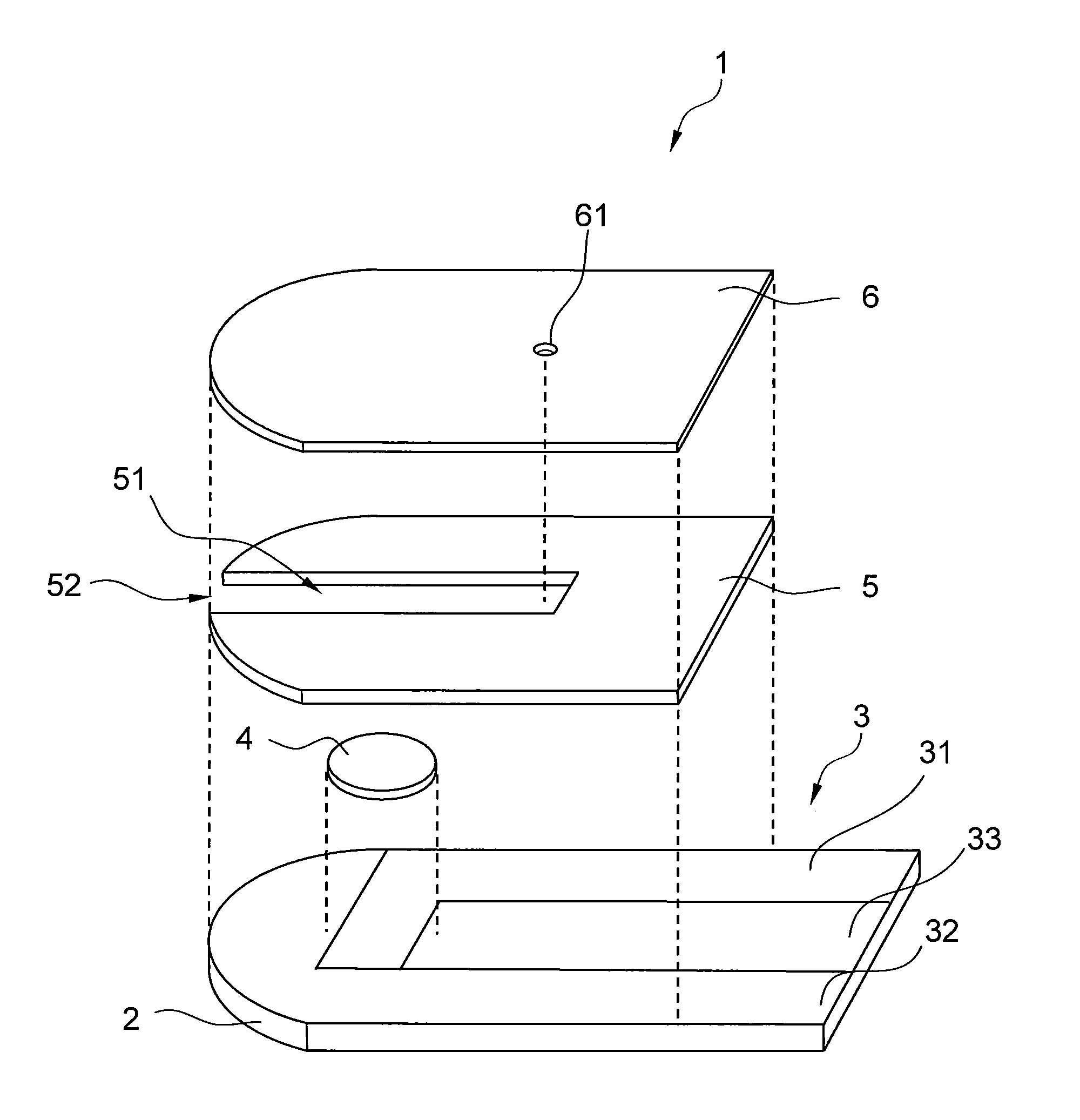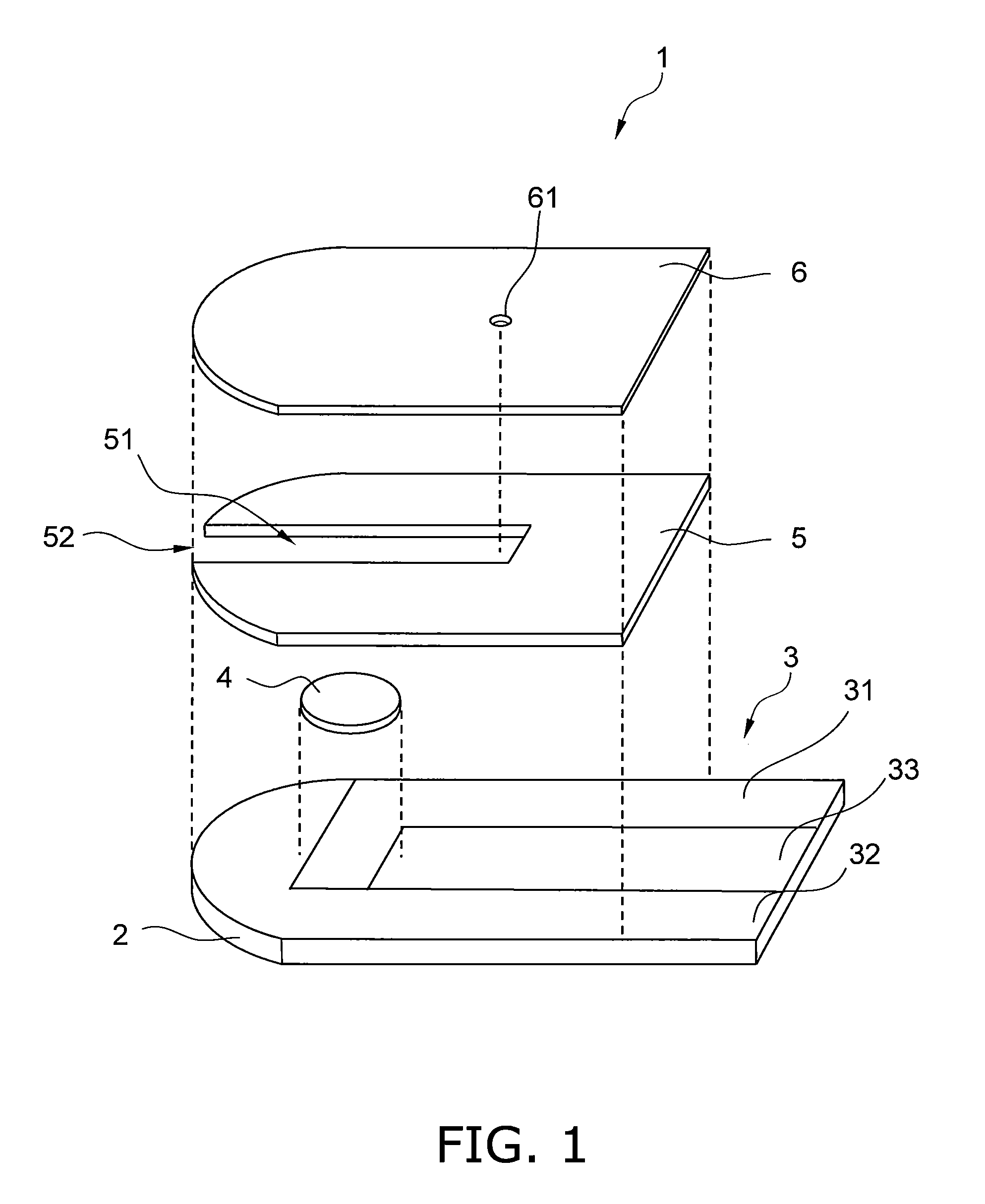Sensor and concentration measurement method
a technology of concentration measurement and sensor, which is applied in the direction of liquid/fluent solid measurement, biomass after-treatment, enzymology, etc., can solve the problems of high solubility of potassium ferricyanide in samples, measurement error caused by other substances present in blood, and measurement error, etc., to achieve the effect of small measurement error
- Summary
- Abstract
- Description
- Claims
- Application Information
AI Technical Summary
Benefits of technology
Problems solved by technology
Method used
Image
Examples
first embodiment
[1] First Embodiment
1-1. Sensor
[0092]1-1-a. Simplified Configuration of Sensor
[0093]A sensor 1 is an example of a sensor comprising a quinone compound, an enzyme, and electrodes. The sensor 1 can detect and / or quantify a target substance in a liquid sample.
[0094]More specifically, the sensor 1 has a substrate 2, a conductive layer 3, a reagent layer 4, a spacer 5, and a cover 6.
1-1-b. Substrate
[0095]As shown in FIG. 1, the substrate 2 is a flat member. The substrate 2 has electrical insulation properties. Examples of the material that makes up the substrate 2 include polyethylene terephthalate, vinyl polymer, polyimide, polyester, styrenics, and other such resins; glass; and ceramics.
[0096]The substrate 2 is not limited to any specific dimensions. However, the width of the substrate 2 is preferably 4 to 20 mm, and more preferably 5 to 10 mm. The length of the substrate 2 is preferably 20 to 40 mm. The thickness of the substrate 2 is preferably 0.1 to 1 mm. The width, length, and thi...
second embodiment
[2] Second Embodiment
[0370]The method pertaining to this embodiment is a method for measuring the concentration of a target substance contained in a liquid sample, comprising the steps of:
[0371](a) bringing into contact the liquid sample, a dehydrogenase or an oxidase, and phenanthrenequinone and / or a derivative thereof;
[0372](b) dehydrogenating or oxidizing the target substance contained in the liquid sample with the dehydrogenase or oxidase;
[0373](c) accepting electrons from the dehydrogenase or oxidase with the phenanthrenequinone and / or derivative thereof;
[0374](d) shining light on the phenanthrenequinone and / or derivative thereof that has accepted electrons in (c) above;
[0375](e) measuring the amount of light emitted from the phenanthrenequinone and / or derivative thereof that has accepted electrons; and
[0376](f) calculating the concentration of the target substance on the basis of the amount of light.
[0377]If the liquid sample being used is one in which water is the solvent, th...
third embodiment
[3] Third Embodiment
[0382]The concentration measurement method pertaining to this embodiment has the same constitution as the method in the second embodiment, except that a first mediator and a second mediator are used.
[0383]Specifically, the concentration measurement method of this embodiment is a method for measuring the concentration of a target substance contained in a liquid sample, comprising the steps of:
[0384](a) bringing into contact the liquid sample, a dehydrogenase or oxidase, and phenanthrenequinone and / or a derivative thereof that is a first mediator;
[0385](b) dehydrogenating or oxidizing the target substance with the dehydrogenase or oxidase;
[0386](c) accepting electrons from the dehydrogenase or oxidase with the phenanthrenequinone and / or derivative thereof;
[0387](d) accepting electrons with a second mediator from the phenanthrenequinone and / or derivative thereof that has accepted electrons in (c) above;
[0388](e) shining light on the second mediator that has accepted...
PUM
| Property | Measurement | Unit |
|---|---|---|
| Electric potential / voltage | aaaaa | aaaaa |
| Molar density | aaaaa | aaaaa |
| Molar density | aaaaa | aaaaa |
Abstract
Description
Claims
Application Information
 Login to View More
Login to View More - R&D
- Intellectual Property
- Life Sciences
- Materials
- Tech Scout
- Unparalleled Data Quality
- Higher Quality Content
- 60% Fewer Hallucinations
Browse by: Latest US Patents, China's latest patents, Technical Efficacy Thesaurus, Application Domain, Technology Topic, Popular Technical Reports.
© 2025 PatSnap. All rights reserved.Legal|Privacy policy|Modern Slavery Act Transparency Statement|Sitemap|About US| Contact US: help@patsnap.com



